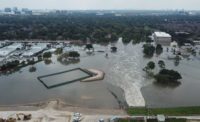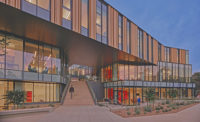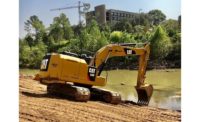Most contractors will characterize having to manage a bustling portfolio of projects as a good problem to have. But for Houston-based Harvey | Harvey-Cleary Builders, that has long been a way of life.
CEO Kelly Hall says while the contractor is widely known for large-scale assignments, its three Texas offices handle some 350 projects per year across sectors ranging from residential towers to manufacturing complexes.
Locations in Washington, D.C., and now in Denver added another 50 jobs to its busy slate. “We can compete in most arenas,” Hall says, adding somewhat understatedly that the firm does “a little bit of everything.” The firm’s name stems from iterations of Harvey family ownership dating to its founding in 1957.
Last year offers an example of how well its strategy has paid off for Harvey | Harvey-Cleary, selected by ENR editors as ENR Texas & Louisiana Contractor of the Year. The firm reported more than $1.75 billion in revenue last year, ranking at No. 58 on ENR’s Top 400 Contractors list, having more than 200 project completions.
Among them was Brava—a 46-story, 373-unit luxury apartment building that stands as Houston’s tallest residential tower—and a 12-story, 360,000-sq-ft medical tower at Baylor St. Luke’s McNair hospital campus in Houston’s Texas Medical Center.
New starts included two major projects in Austin—The Republic, a 48-story, 801,000-sq-ft office building and 415 Colorado, a 50-story office and residential tower—as well as Kimpton La Villata, a 10-story boutique hotel in downtown San Antonio.
Other major projects include redevelopment of the 550,000-sq-ft U.S. Postal Service headquarters in Houston into a 16-acre mixed-use facility and Texas A&M University’s Innovation Plaza, which will provide a 19-story student housing tower, a 17-story medical tower and a 13-level parking garage with completion slated for next year. Distribution facilities have also proven to be a lucrative sector for Harvey | Harvey-Cleary, with Hall estimating the company has built as much as 15 million sq ft in locations across Texas over the last few years.
Kevin Rogge, president, says having a concurrent presence in so many markets has helped Harvey | Harvey-Cleary navigate the uncertainties of a regional construction market that, while generally strong, has still experienced challenges of the pandemic and high interest rates that have curbed commercial development. Market diversity, Rogge says, “has helped us chug through some difficult times. If one market’s down, another one is up.”

Other Harvey projects include the Atlassian corporate hub build-out in Austin (top) and the 46-story Brava mixed-use high-rise in Houston (below).
Images courtesy Harvey | Harvey-Cleary

A reliable source
Hall says the key to Harvey | Harvey-Cleary’s approach is a commitment to consistency in both price and scheduling—not an easy task in an era of escalating costs and supply chain disruptions.
With such a large volume of projects underway or in the pipeline, he adds, it’s essential for the firm to have an accurate, real-time understanding of the materials market. When necessary, project teams have scouted out new sources and adopted out-of-the box tactics such as bypassing subs to work directly with suppliers.
“We try to make things more predictable for the owners,” Hall says. “When you do that, they can rely on you and they’re going to hire you.”
Brian Richard, executive vice president of Houston-based Kirksey Architects, can attest to the benefits of Harvey | Harvey-Cleary’s experience and resourcefulness.
The firm has “the ability to begin a project with a very good understanding of the technical scope, which will translate into a realistic estimation of the cost,” says Richard, whose firm has several decades of experience working with Harvey | Harvey-Cleary. “We can then manage the project scope and the cost from the top down and remain within budget throughout the duration.”
“We try to make things more predictable for the owners. When you do that, they can rely on you and they’re going to hire you.”
— Kelly Hall, CEO, Harvey | Harvey-Cleary
Richard describes a current laboratory project for a client he won’t identify as requiring highly specialized electrical and mechanical infrastructure. Rather than having to wait for the systems to be fully designed and engineered, Harvey | Harvey-Cleary’s early involvement provided valuable cost, constructibility and scheduling input that Richard says “lays out a holistic picture and path forward for the project.”
Consistency also includes adapting to shifting owner priorities, including more emphasis on sustainable construction and building performance. Scott Clarke, Harvey | Harvey-Cleary executive vice president and managing partner, says an internal sustainability committee helps identify the best ways to help owners shrink their carbon footprint.
“We took a similar approach when LEED was new,” he explains. “We’re collaborating with designers and specialists to better understand both current and emerging options and their viability for various types of buildings.
Not everything is easy. Clarke says that some items such as MEP components continue to have lengthy lead times. “At least now you can plan around and control it in preconstruction, although there are still problems on the cost side,” he says.
Skilled labor, however, remains the biggest challenge. “Many experienced people have been promoted into supervisory roles, so there are fewer available for day-to-day work,” Clarke adds.

The firm’s work extends beyond Texas, including construction of office space for health services provider Maximus in Washington, D.C.
Image courtesy Harvey | Harvey-Cleary
Building safe ... and smart
Perhaps the most consistent element of Harvey | Harvey-Cleary’s approach over the years has been safety, which Hall says involves both office and field personnel. The focus has been particularly important in identifying opportunities to further minimize work-related risks.
“We require all employees to do safety observations and log anything they see into our database,” Hall explains. “If we start to see negative trends—say, foot or hand injuries or lockout/tagout issues—we’ll immediately do training on it firmwide.”
Training is also a fundamental component of Harvey | Harvey-Cleary’s strategy to recruit and retain the talent necessary to keep its packed project portfolio on track. Hall says the company has been expanding its recruiting reach beyond the borders of its traditional geographic footprint. New hires are enrolled in a three-year training program that immerses them in company culture and history. The program then expands to developing leadership skills, from analyzing project “lessons learned” to cross-training in project roles.
“If you put the effort in, you’ll get that in return from employees,” Hall says of the company’s training investment. “We have some of the best employees and best construction people in the country.”
The only disadvantage, Rogge admits, is that the rest of the construction industry recognizes that as well, creating the potential of staff members being lured away by rival firms. “We do what we can to keep them here,” he says, “but the effort is worth it.”
Mirroring the diversity of Harvey | Harvey-Cleary’s business strategy is its extensive community outreach program, whether it’s raising money or employees contributing time to local and national causes. Trade partners are also encouraged to get involved. Among the beneficiaries are Rebuilding Together, a nonprofit dedicated to repairing homes of people in need, and Covenant House, which serves homeless youth.

Harvey l Harvey-Cleary built the Montrose Collection, an upscale shopping mall in Houston.
Putting the future in focus
While Harvey | Harvey-Cleary’s diversity-based strategy would appear to have the company well positioned to handle whatever challenges and opportunities the regional construction market may present in the coming months, company leaders admit the landscape still holds no shortage of uncertainties. “The biggest challenge will be continuing to find opportunities that won’t be impacted by market conditions,” says Rogge, citing health care, mission critical and light industrial-R&D and technology as remaining strong.
Clarke also sees more interest in repurposing existing offices into residential and mixed-use space, “a big part of the culture change that COVID-19 left us,” he says.
Still, Hall feels there’s room for optimism—maybe not for the rest of this year, he says, “but 2024 and 2025 have the potential to be a good time.”





Post a comment to this article
Report Abusive Comment